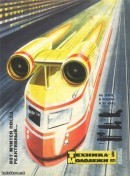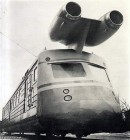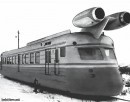As we're about to step into 2015, many of us are wondering why the future hasn't yet arrived. Where are the flying cars, the teleportation devices and… talking monkeys that have taken over the world? All we have is the Tesla Model S and the overpriced iPhone 6.
Everybody used to dream big, of going faster than ever on land, sea and through the air. Was Chuck Yeager thinking of zero emissions when he strapped himself to the X1 rocket and went supersonic for the first time? I think not.
Everybody knows about the race to the moon, or the nuclear arms race, but there's another element of the cold war that's less famous and it involves train transport.
Both the USSR and the US of A tried to develop trans that used jets to propel themselves to huge speeds. What a crazy idea that was, and yet both companies built and tested such machines.
The Russian project was called SVL, a Russian abbreviation for high-speed laboratory car. In the 1970s, they strapped a couple of jets from the Yak-40 commercial aircraft to the top of an ER22 train and voila!
We can't seem to find any video footage of the train in action, but there is a short video of its American equivalent. They tried pretty much the same thing on the New York central rail road, using a modified version of the Budd RDC. The top speed they reached was 183.85 miles per hour or 295.99 km/h.
By today's standards that's a pedestrian speed. French TGVs have been using 300 km/h (186 mph) as their standard cruising speed for many, many years now, and they’ve recently started to go faster on scheduled routes. Japan, Germany and China all have trains that can clock 500 km/h (310 mph).
Everybody knows about the race to the moon, or the nuclear arms race, but there's another element of the cold war that's less famous and it involves train transport.
Both the USSR and the US of A tried to develop trans that used jets to propel themselves to huge speeds. What a crazy idea that was, and yet both companies built and tested such machines.
The Russian project was called SVL, a Russian abbreviation for high-speed laboratory car. In the 1970s, they strapped a couple of jets from the Yak-40 commercial aircraft to the top of an ER22 train and voila!
We can't seem to find any video footage of the train in action, but there is a short video of its American equivalent. They tried pretty much the same thing on the New York central rail road, using a modified version of the Budd RDC. The top speed they reached was 183.85 miles per hour or 295.99 km/h.
By today's standards that's a pedestrian speed. French TGVs have been using 300 km/h (186 mph) as their standard cruising speed for many, many years now, and they’ve recently started to go faster on scheduled routes. Japan, Germany and China all have trains that can clock 500 km/h (310 mph).







